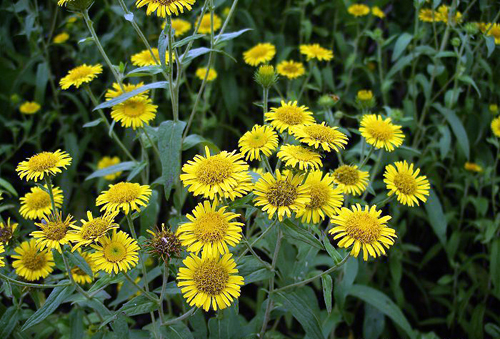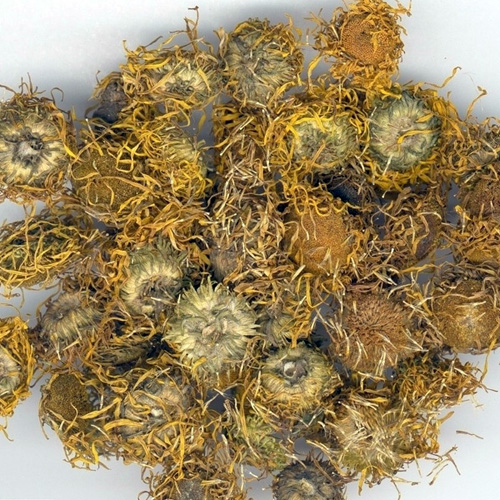The source is from the capitulum of Inula japonica Thunb., family Compositae. The medicinal material is mainly produced in North China, East China and provinces of lower reaches of the Yangtze River, collected in summer and autumn when the bud is open, dried in the sun and the crude one or the one roasted with honey is used.
Medicinal Properties: Bitter, pungent and salty in flavor, slightly warm in nature and attributive to the spleen, lung, stomach and large intestine meridians.
Actions: Descend the adverse-rising qi, resolve phlegm and arrest vomiting.

Application
1. It is used for phlegm-fluid accumulation in the lung with cough, excessive phlegm, phlegm-retention and sensation of fullness in the chest and hypochondrium. For cough and dyspnea of cold-phlegm type that is companied with superficial syndrome, it is usually combined with Shengjiang ( Rhizoma Zingiberis Recens ) , Banxia ( Rhizoma Pinelliae) and Xixin (Herba Asari), such as Jinfucao San (Powder); for sthenia-syndrome of phlegm-heat type manifested as cough and dyspnea, it is usually combined with Jiegeng (Radix Platycodi ), Sangbaipi ( Cortex Mori Radicis ) and Gualou ( Fructus Trichosanthis ), etc.
2. For deficiency of spleen-qi and stomach-qi, and adverse ascending of phlegm manifested as vomiting, belching and epigastric fullness, it is usually combined with Daizheshi ( Haematitum ), Banxia ( Rhizoma Pinelliae ) , Shengjiang ( Rhizoma Zingiberis Recens ) and Renshen (Radix Ginseng), etc., such as Xuanfu Daizhe Tang (Decoction).
Usage and Dosage:
3 - 10 g is used in decoction for oral use, which is wrapped with cloth for being decocted.
Notes:
Contraindicated for tuberculosis with cough due to yin deficiency, dry cough due to injury of the body fluids.








